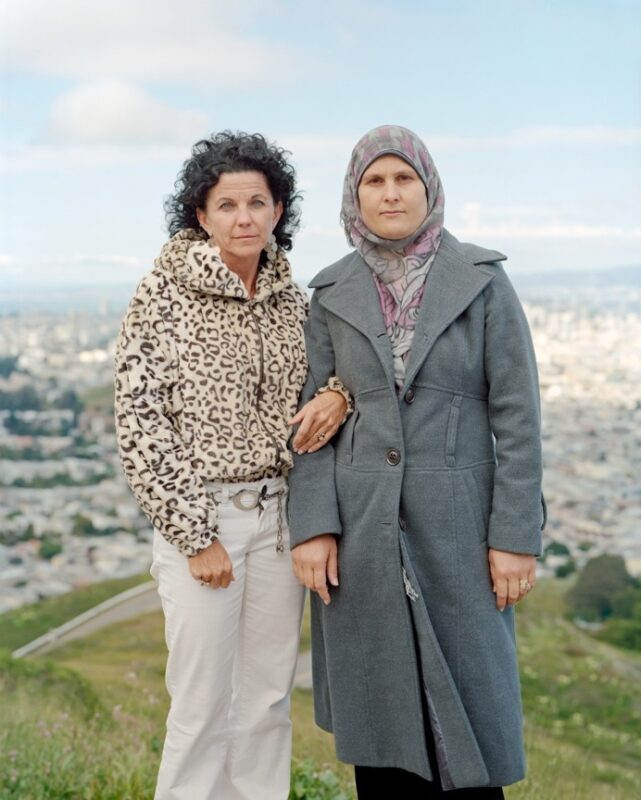Photographer Richard Renaldi approaches his work through a “humanist” lens. Curiosity about people, their environments and how they interact with each other drives the many projects Renaldi has done over the years including his latest, Touching Strangers. For the project Renaldi, using a large format eight-by-ten inch view camera, pairs strangers up and “invites them to pose together, intimately, in ways that people are usually taught to reserve for their close friends and loved ones.” Featured on CBS News and other media outlets, the much beloved project is now available as a book and is currently on view in New York at Aperture Gallery, (curated by Ann Pallesen, director of Photographic Center Northwest, Seattle) as part of a touring exhibition. In conversation with Visual AIDS, Renaldi discusses the role stigma plays in Touching Strangers, how the work relates to past projects, and his own fears when approaching subjects.
Visual AIDS: Looking at Touching Strangers, I am reminded of the fear many people had—and some still do—around touching, or being intimate with people living with HIV. I wonder if this was something you were thinking about when you did the project?
Richard Renaldi: No it wasn't consciously on my mind. Though I wouldn't argue that it's not possible that I might have been subconsciously projecting HIV/AIDS stigma onto the concept when I originally conceived the idea. More consciously I had been thinking somewhat about the boldness I exhibited as a very young gay man in my adolescent sexual pursuits seeking discreet encounters with men nearly twice my age and how that experience facilitated a certain brazenness I now possess in asking complete strangers to do something extraordinary for me and my camera. Additionally as a person who is "familiar" with the "culture" of sexual promiscuity I think I developed an understanding of the potential we possess to engage in very intimate moments with complete strangers on such a primal level.
Visual AIDS: Touching Strangers seems like a series of very interesting encounters. What has been a memorable moment from the process?
RR: I am going to share in except from my essay in the book here. It's a good story I think Visual AIDS blog readers will appreciate.
On San Francisco’s Twin Peaks, I once asked a woman from South Carolina with a deep southern accent named Annalee if she would volunteer to be in one of the portraits. She reluctantly agreed. I went looking for her companion. Moments later, I saw a Muslim woman wearing a hijab walking with her husband. I had been trying for years to cast a traditionally-dressed Muslim woman, and had always been turned down. I began to wonder if Annalee, waiting in the distance, would see me asking a Muslim woman and change her mind. I had a notion that Southerners were generally prejudiced against Muslims, and I worried that I was now potentially responsible for subjecting the Muslim woman, who introduced herself as Rayqa, to a painful incidence of intolerance. Rayqa’s husband gave her permission to pose for me, but she refused. Dejected, I went looking for another person to pose with Annalee when I heard a shout, “Hey, Photographer!” The two women were holding hands. Annalee had intercepted Rayqa, introduced herself, and asked to her to be in the picture with her.
Visual AIDS: What has been some of the feedback from people once they see the photos?
RR: Many have said that it was a unique experience and "cool" experience. Definitely something unexpected in the course of their day.
Visual AIDS: A lot of your work is about seeing people in their most human and interconnected moments. I wonder how you see this series in relation to Workers or Figure and Ground?
RR: I think there is a definite connection between Touching Strangers and this other work. I'd suggest that there is a "humanist" thread in much of my work and that Touching Strangers was an organic progression of what I had been saying or showing with my earlier projects. The trigger for the idea of asking strangers to touch for a photograph grew out of my thinking about the relationship between the enduring travelers waiting on the long communal benches in my series See America by Bus.
Visual AIDS: There is serenity to your work. What is the experience of being behind the camera for you?
RR: Good question. It's panic-stricken! Seriously I wish I was a little calmer during the photography sessions but I have so much to think about. I sometimes feel like I missed finding out more personal details of the subjects lives but I really have to focus on making the image and all that comes with that including composition, exposure, focus, directing the subjects, light, etc.
Learn more about Touching Strangers, including how to buy the book, see the exhibition—and be involved—by visiting touchingstrangers.org.
Richard Renaldi was born in 1968 in Chicago, IL, and received his BFA in photography from New York University. Exhibitions of his photographs have been mounted in galleries and museums throughout the United States and Europe, including the House of Photography in Stockholm; The Robert Morat Gallery in Hamburg; The Nicolaysen Museum in Casper, Wyoming; the Gallery at Hermès and Yossi Milo Gallery in New York. Renaldi’s work has also been exhibited in numerous group shows, including Strangers: The First ICP (International Center of Photography) Triennial of Photography and Video (2003). In 2006 Renaldi's first monograph, Figure and Ground, was published by the Aperture Foundation. His second monograph, Fall River Boys, was released in 2009 by Charles Lane Press. In 2014, Touching Strangers was published by Aperture Foundation. Richard Renaldi is the founder and publisher of Charles Lane Press. Learn more at: renaldi.com

